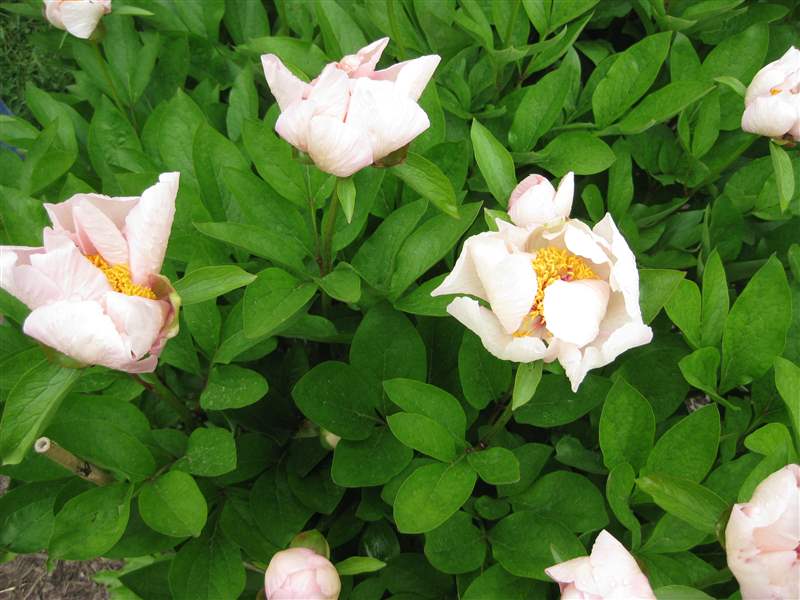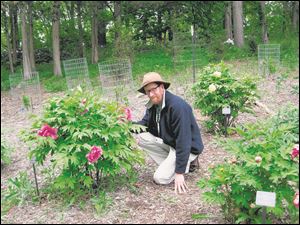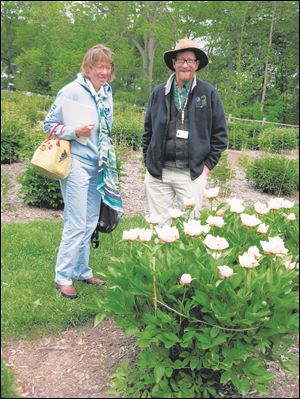
HOME & GARDEN
Peonies Galore: Ancient perennial gets royal treatment at Nichols Arboretum
5/27/2015
The Nichols Arboretum at the University of Michigan has 200 varieties of heirloom of peonies.
The Blade/Tahree Lane
Buy This Image

David Michener, associate curator at Matthaei Botannical Gardens and Nichols Arboretum, takes a closer look at some of the peonies in the garden.
The fattest and most scrumptious of all flowers, a rare fusion of fluff and majesty, the peony is now coming into bloom. – The late Henry Mitchell, Washington Post columnist
ANN ARBOR — They’re beginning to pop, these luxurious blossoms that laugh in the face of bitter cold, boast stout constitutions and longevity, loathe moving, and snarl at soggy feet.
Peonies, old-fashioned sun worshippers, are gorgeous explosions and superior cut flowers. And, they just might be on the cusp of refreshed popularity, particularly with a new hybrid called Itoh.
On a swath of 123 green acres next to seven University of Michigan hospitals, 400 well-tended bushes are each staked with bamboo poles and encircled by twine. Here in Nichols Arboretum are two each of 200 varieties dating to before 1950 and therefore called heirlooms.
On a nearby slope, tree peonies from Japan, Korea, and China grow: one sumptuous bloom streaked pink and white bears the name “Young Yuhuan, Drunken Imperial Concubine.” One can only imagine how honored Yuhuan must have felt. From now to about June 10 (depending on heat, cold, and whether a thunderstorm washes away the blooms), thousands of people will stroll the arboretum’s grassy paths holding laminated photo-maps and hunting for bushes named for famous ladies (such as the Parisian stunner Sarah Bernhardt), or aromatic varieties, or favorites of early peony lover William Upjohn. Signs are in English and Mandarin (because of the number of visitors who speak it) and volunteers will answer questions. Half the varieties in this collection cannot be commercially purchased, said David Michener, a curator at the Matthaei Botanical Gardens and Nichols Arboretum at UM.
Celebrate peonies at:
■ Peonies Galore Sale, 10 a.m Saturday. until sold out, at Nichols Arboretum, 1610 Washington Heights, Ann Arbor. For parking (it is difficult) and more information: mbgna.umich.edu/peony.
■ Chinese flower songs will be performed in Mandarin in Nichols Arboretum’s peony garden, at 2 p.m. June 7. Free.
■ Peony Walk at Koelsch Farm Homestead, 200 bushes, 10 a.m. to 4 p.m. June 6, noon to 5 p.m. June 7.
■ Van Wert Peony Festival will be June 5 to 7 with activities ranging from an antique car show, Connor Rose concert 7 p.m. June 6, garden tours, and a 5 p.m. Saturday parade with 98 units. Information: 419-419-203-5732 and vwpeony.com.
The ephemeral quality of the peony blossom is appreciated in Oriental cultures, Mr. Michener said. Arboretum staff calls these beds “North America’s heritage peony reference site” and give peonies diva treatment: the area around these beds is designed so that nothing else blooms when little miss fancy pants is at her best.
The common peony most of us know comes from a white/pale pink flower indigenous to regions from China to Siberia, and originally looked “kind of like a wild rose,” said Mr. Michener, who is “fingerprinting” the DNA of peonies.
Another type is the tree peony, with woody stems, larger flowers, and a broader color range. First found growing in mountainous China, it was crossed with bush peonies in the 1940s and named Itoh after the man who devoted years to hybridizing it. Growing in popularity, Itoh combines the best of bush and tree — more and bigger flowers, more colors, stronger upright stems that don’t need staking, long lived — and is priced from $35 to $300.
Nearly a century ago, many universities had gardens with hundreds of varieties but UM’s is the only one to survive. It was a hobby especially popular with men, and William Upjohn, of Kalamazoo, founder of the Upjohn Co. donated many of his rootstock to UM where 132 of his favorites continue flourishing.

Vicki Koelsch of Metamora, Ohio, and David Michener take a stroll through the peony garden.
At Claude Monet’s garden at Giverny, France, the painter planted a carpet of pansies and scattered tulip bulbs throughout his peony beds.
Mr. Michener said the UM beds are being expanded so they can be well established for the 2022 American Peony Society conference slated to be held in Ann Arbor. Added will be beds dedicated to historic Korean and French peonies, Japanese, pre-1950s Chinese, and modern hybrids.
A hundred miles southwest of Toledo, the Van Wert Peony Festival will be June 5 to 7 with a parade featuring a Peony Queen at 5 p.m. Saturday. Around 1900, a Van Wert piano teacher with an avid interest in peonies interested her neighbors in growing the cold-hardy plant. Three businessmen who were hobby gardeners, began growing them by the thousand and selling the rootstock.
Located on U.S. 30, then called the Lincoln Highway and a major east-west route that crossed the country, Van Wert was an easy place to find and by the late ’20s and ’30s, tens of thousands from Ohio, Indiana, Michigan, and Illinois poured into town in early June to gaze upon fields abloom at seven commercial growers,
Taking a page from the May Tulip Festival in Holland, Mich., businessmen launched the Peony Festival in 1932, which, after World War II, was reported to have drawn 100,000 people. Van Wert’s peony industry gradually waned and the last commercial enterprise shuttered in the 1960s.
Closer to Toledo, the Koelsch Family Homestead in Metamora invites the public to visit its 200-some peony bushes June 6 and 7. Several Koelsch siblings and their spouses live on and near the farm that’s been in the family for more than a century, tending to its flowers, pond, and an old farmhouse they rent out.
Suggestions for peony growers:
■ Deer do not like peonies. Ants, however, adore them and scour the plant for its tiny sugar excretions. To rid ants before cutting flowers, flick your fingers against the stem to knock them off or, after cutting, swish the blooms quickly in a bucket of water, followed by a gentle shaking.
■ Insider information: The darker the stem’s color, the darker the flower will be.
■ Following a killing frost in fall, cut down and discard peony foliage to reduce the chance of fungal diseases.
■ When buying, select what you love: all are reliable and hearty, providing they have well-drained soil and plenty of sunshine.
■ Helpful Web sites are peony.ca and americanpeonysociety.org.
Contact Tahree Lane at: tlane@theblade.com and 419-724-6075.